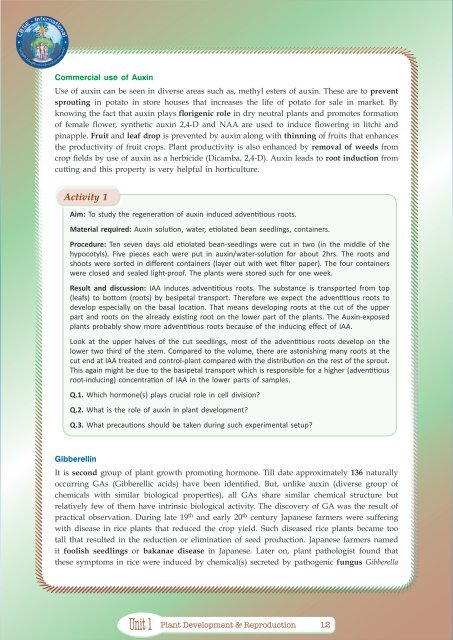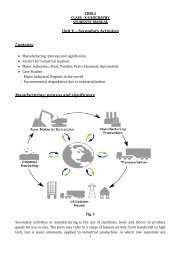PLANT DEVELOPMENT & REPRODUCTION - CBSE International
PLANT DEVELOPMENT & REPRODUCTION - CBSE International
PLANT DEVELOPMENT & REPRODUCTION - CBSE International
You also want an ePaper? Increase the reach of your titles
YUMPU automatically turns print PDFs into web optimized ePapers that Google loves.
Commercial use of AuxinUse of auxin can be seen in diverse areas such as, methyl esters of auxin. These are to preventsprouting in potato in store houses that increases the life of potato for sale in market. Byknowing the fact that auxin plays florigenic role in dry neutral plants and promotes formationof female flower, synthetic auxin 2,4-D and NAA are used to induce flowering in litchi andpinapple. Fruit and leaf drop is prevented by auxin along with thinning of fruits that enhancesthe productivity of fruit crops. Plant productivity is also enhanced by removal of weeds fromcrop fields by use of auxin as a herbicide (Dicamba, 2,4-D). Auxin leads to root induction fromcutting and this property is very helpful in horticulture.Activity 1Aim: To study the regeneration of auxin induced adventitious roots.Material required: Auxin solution, water, etiolated bean seedlings, containers.Procedure: Ten seven days old etiolated bean-seedlings were cut in two (in the middle of thehypocotyls). Five pieces each were put in auxin/water-solution for about 2hrs. The roots andshoots were sorted in different containers (layer out with wet filter paper). The four containerswere closed and sealed light-proof. The plants were stored such for one week.Result and discussion: IAA induces adventitious roots. The substance is transported from top(leafs) to bottom (roots) by besipetal transport. Therefore we expect the adventitious roots todevelop especially on the basal location. That means developing roots at the cut of the upperpart and roots on the already existing root on the lower part of the plants. The Auxin-exposedplants probably show more adventitious roots because of the inducing effect of IAA.Look at the upper halves of the cut seedlings, most of the adventitious roots develop on thelower two third of the stem. Compared to the volume, there are astonishing many roots at thecut end at IAA treated and control-plant compared with the distribution on the rest of the sprout.This again might be due to the basipetal transport which is responsible for a higher (adventitiousroot-inducing) concentration of IAA in the lower parts of samples.Q.1. Which hormone(s) plays crucial role in cell division?Q.2. What is the role of auxin in plant development?Q.3. What precautions should be taken during such experimental setup?GibberellinIt is second group of plant growth promoting hormone. Till date approximately 136 naturallyoccurring GAs (Gibberellic acids) have been identified. But, unlike auxin (diverse group ofchemicals with similar biological properties), all GAs share similar chemical structure butrelatively few of them have intrinsic biological activity. The discovery of GA was the result ofpractical observation. During late 19 th and early 20 th century Japanese farmers were sufferingwith disease in rice plants that reduced the crop yield. Such diseased rice plants became tootall that resulted in the reduction or elimination of seed production. Japanese farmers namedit foolish seedlings or bakanae disease in Japanese. Later on, plant pathologist found thatthese symptoms in rice were induced by chemical(s) secreted by pathogenic fungus GibberellaUnit 1 Plant Development & Reproduction 12








